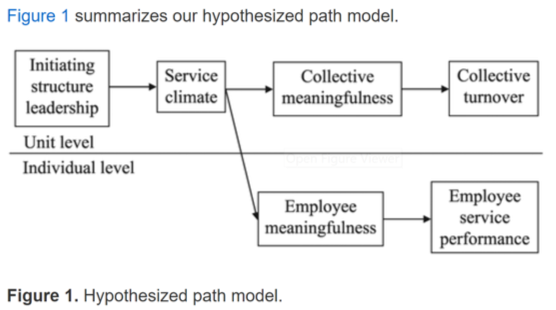Dodging Burnout and Minimizing Turnover
Fred O. Walumbwa, PhD, I-Chieh Hsu, PhD, Cindy Wu, PhD, Everlyne Misati, PhD Candidate, and Amanda Christensen-Salem, PhD
It is no secret that real estate agencies rely almost entirely on the high-quality service of their agents to maintain an edge over their competitors. Arguably, an organization’s employees are its most valuable assets, especially in service-related industries such as real estate. The service industry represents the largest area of growth for the United States economy—responsible for nearly 80% of total employment in the US—and is increasingly expanding to become a source of global competitive advantage.
Interestingly, studies have shown that these service-related jobs, including careers in real estate, can have negative impact on employees. Possible adverse effects include burnout and decreased motivation, which in turn leads to higher employee turnover within an organization.
About Our Study
 How can real estate agencies and managers lessen these impacts on their agents? We aim to answer this question and find practical ways of increasing employee performance and decreasing employee turnover within organizations. A sample of roughly 550 individuals within the service industry was collected. We suspected that incorporating initiating structure leadership would have a direct or indirect impact on four key areas including service climate, collective and individual meaningfulness, service performance, and collective turnover, ultimately resulting in increased employee and organizational well-being (see Figure 1).
How can real estate agencies and managers lessen these impacts on their agents? We aim to answer this question and find practical ways of increasing employee performance and decreasing employee turnover within organizations. A sample of roughly 550 individuals within the service industry was collected. We suspected that incorporating initiating structure leadership would have a direct or indirect impact on four key areas including service climate, collective and individual meaningfulness, service performance, and collective turnover, ultimately resulting in increased employee and organizational well-being (see Figure 1).
Initiating Structure Leadership
Initiating structure leadership is leader behavior that involves clarifying follower expectations, roles, and responsibilities. Those with this leadership style are oriented toward getting work done and establishing well-defined patterns of work and channels of communication. Leaders not only set priorities and define task roles and responsibilities among group members, but they also clarify the means by which the work is to be achieved and provide resources to help employees achieve those goals and objectives. Additionally, good managers maintain definite standards of performance. Essentially, leaders should be clear in defining policies, practices, and procedures that constitute the tone and atmosphere in which employees work.
Impact of Initiating Structure Leadership
As shown in in Figure 1, our hypothesized relationships are that initiating structure leadership leads to a stronger service climate, which then results in meaningfulness and lower collective turnover. These relationships were confirmed through our research. With a clear understanding of what is expected and rewarded in the work unit (from leadership that initiates structure), the service climate is enhanced. A service climate is an employee’s shared perception of the policies, practices, and procedures concerning customer service. Because of added buy-in, employees find meaningfulness in their work. Leadership arguably represents the most important of all contextual factors that affect motivation, because leaders manage meaning by defining and shaping reality in which followers work. Meaningfulness is not something leaders give employees; rather, it is the responsibility of leaders to create the right work environment that then serves to shape work meaningfulness. Outcomes of collective meaningfulness and employee meaningfulness can be seen at both the unit and individual levels:
- Unit level: Meaningfulness within an organization has been shown to reduce the collective turnover level of employees who exit either a group, work unit, or organization. Turnover can cause large disruptions and erosion of company culture or climate and represents a monetary loss associated with training replacements. When an employee leaves, the organization also loses that individual’s knowledge, skills, and abilities. Satisfied employees are more likely to support each other by building environments that are associated with lower turnover. Put simply, people stay if they are satisfied with their job and committed to their organization and leave if they are not.
- Individual level: Employees who find meaningfulness at work have been found to have a higher level of service performance. Employees who find their job meaningful are also likely to integrate different viewpoints to identify innovative ideas, provide quality service to their customers, and also exhibit enthusiasm toward addressing potential customers issues and problems. Consider, for example, how much more satisfactory is such an employee’s performance regarding understanding the needs of customers.
Practical Implications
Initiating structure highlights the importance of task-related leadership behaviors in creating work environments conducive to motivation and performance. Training programs that focus on task-oriented forms of leadership may be a worthwhile investment in striving to increase employee motivation and, as a result, higher levels of service performance. Managers should also pay close attention to creating a motivating work environment, where work duties and roles are well defined and specific goals are set. A manager should strive to align an agent’s individual work goals and values with those of the work unit/agency.
 Our findings indicate work units/agencies have lower turnover rates when there are higher levels of collective meaningfulness. This suggests that managers/agencies invest in tangible programs that encourage and facilitate meaningfulness, such as training in areas that directly impact an agent’s knowledge and expertise. A manager can get creative in finding ways to stimulate motivation and ensure agents are energized and meaningfully engaged in their work. Inviting in guest speakers, taking time to focus on employees’ personal and professional development, creating reward programs to recognize excellence, or simply sending out motivational emails are good places to start.
Our findings indicate work units/agencies have lower turnover rates when there are higher levels of collective meaningfulness. This suggests that managers/agencies invest in tangible programs that encourage and facilitate meaningfulness, such as training in areas that directly impact an agent’s knowledge and expertise. A manager can get creative in finding ways to stimulate motivation and ensure agents are energized and meaningfully engaged in their work. Inviting in guest speakers, taking time to focus on employees’ personal and professional development, creating reward programs to recognize excellence, or simply sending out motivational emails are good places to start.
Managers should strive to create work environments conducive to employee motivation and performance by implementing initiating structure leadership, which has been confirmed to enhance employee service performance and reduce turnover.
. . . . . . . . . . . . . . . . . . .
Recommended Reading
Walumbwa, Fred O., I-Chieh Hsu, Cindy Wu, Everlyne Misati, and Amanda Christensen-Salem (2019), “Employee Service Performance and Collective Turnover: Examining the Influence of Initiating Structure Leadership, Service Climate and Meaningfulness,” Human Relations, 72(7), 1131-1153.
. . . . . . . . . . . . . . . . . . .
About the Authors
Fred O. Walumbwa, PhD
Associate Professor of International Business, Florida International University
Dr. Fred O. Walumbwa (PhD – University of Illinois at Urbana-Champaign) has authored or co-authored more than 90 academic technical reports, book chapters, and research papers in a wide range of prestigious journals in business, management, and psychology. He was recently recognized as one of the top 2% most influential authors in industrial and organizational psychology globally.
I-Chieh Hsu, PhD
Professor, National Changhua University of Education
Dr. I-Chieh Hsu’s (PhD – The University of Manchester) research focuses on leadership and organizational influences on employee motivation and behavior. His work extends to include understanding how organizational innovation and capabilities are created, developed and strengthened. He publishes in business and management journals.
Cindy Wu, PhD
Associate Professor of Management, Baylor University
Dr. Cindy Wu’s (PhD – University of Illinois at Urbana-Champaign) research focuses on employee wellness by examining individual, team, organizational, legal, cultural and other contextual factors that enhance or hinder human flourishing. She has published in top academic journals in business, management, and psychology, including the Journal of Applied Psychology, Journal of International Business Studies, and Human Resource Management.
Everlyne Misati, PhD Candidate
Florida International University
Everlyne Misati’s primary research interests lie at the intersection of strategy, international business, and entrepreneurship. She is also interested in examining the micro foundations of these macro areas, for example, the role of individuals, top management (leaders), and their interactions in driving firm-level outcomes.
Amanda Christensen-Salem, PhD
Assistant Professor of Management, University of Cincinnati
Dr. Amanda Christensen-Salem’s (PhD – Arizona State University) core research examines topics that span organizational behavior and strategy research boundaries, including leadership at the managerial and CEO levels, family firms, organizational climate, and firm performance. Her work has been published in several top peer-reviewed journals, including Organizational Behavior and Human Decision Processes and The Leadership Quarterly.